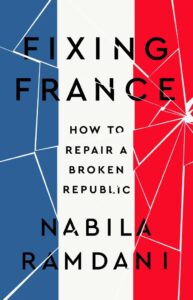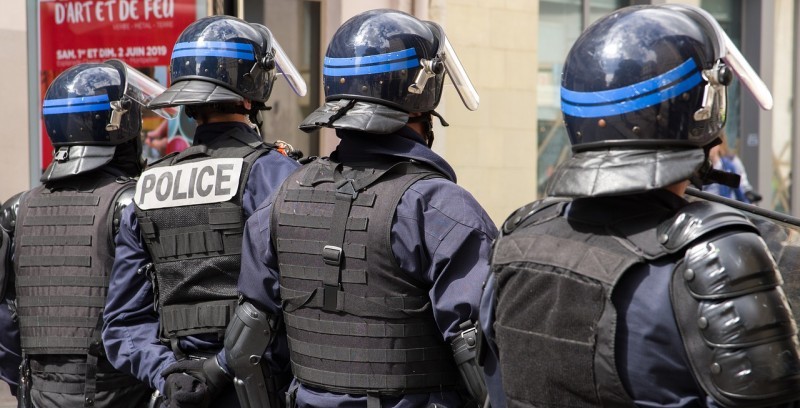“Terror is nothing else than justice, prompt, severe, inflexible.”
— Maximilien de Robespierre (1758–1794)
There were unwitting cheers when the first suicide bomber in France’s history blew himself and a bystander up outside the Stade de France. To begin with, hardly anybody knew what the explosion really signified: most assumed it was a supersized firecracker ignited by a rowdy football supporter during a friendly between Les Bleus and Germany at the national stadium. The France defender on the ball looked mildly concerned as he played a clumsy back pass in the opposite direction to where he was looking, but otherwise the match went on.
It was 9:20 p.m. on November 13, 2015, an unseasonably warm Friday night. President François Hollande was among the eighty thousand people packed into one of the great symbols of modern France. It was here, in 1998, that a team of Frenchmen from numerous ethnic backgrounds had won the World Cup, uniting an unofficially multicultural nation in glory. The arena, in the northern Paris suburb of Saint-Denis, became a resplendent distraction from the kind of social problems that plagued the troubled cités surrounding it. Le Stade represented nationalistic pride and passion, a place of sporting greatness showing off the very best of a united Republic.
Terror…was essential to the founding and development of the current Fifth Republic.
None of that mattered to the foreign-born terrorist who set off his explosives belt outside Gate D, on the Rue Rimet. The killer—a recent immigrant from Iraq or Syria whose identity has never been firmly established—had been seen in the toilets of a fast- food outlet a few minutes before, wiping sweat off his face and shaking visibly as he stared into a mirror. Then came the blast and accompanying low thud.
At pretty much the same time, the rattle of assault rifles broke through the conversation and laughter outside a bar less than ten miles away. It was called Le Carillon, a word that means “chime” in English. Many of those drinking and smoking on the packed terrace near the Canal Saint-Martin also thought firecrackers were going off. Again, there were one or two cheers at the loud noise, especially from those who had been drinking since arriving from work. Some of those sitting on wooden chairs or springless sofas inside jumped up, peering through the windows in the mauve-painted wood façade, beyond the blackboards offering pints of beer for €3 and free Wi- Fi. Their faces were young and inquisitive. All stayed put, refusing to believe that unusual bangs could upset their night out.
Then blood began to spurt on to the pavement on Rue Bichat. It mixed with the spilled drinks and cigarette butts. There were screams of agony and panic. Gunmen wearing suicide belts packed with explosives could be seen picking off targets at will. The bars and restaurants were in the 10th Arrondissement of Paris, and just a stroll from the offices of Charlie Hebdo, the magazine that had lost cartoonists and other staff in a gun attack in January of that year. Police commandoes and army units had flooded historic boulevards and squares in the hunt for the Charlie Hebdo attackers before they, too, were eliminated. Around the same time, another terrorist laid siege to a kosher supermarket and killed four Jewish shoppers before he himself was killed by police.
By November, France had raised security to its highest level, deploying troops in all major cities. The government had pledged a crackdown on radicals and the ease with which they had acquired weapons, but it would make no difference. The Friday, November 13 killers moved around Paris as if they owned the place, maiming at will. During a single night of horror, they succeeded in killing 130 people and wounding more than 400. Worst hit was the Bataclan music venue, on the Boulevard Voltaire. Almost 1,500 people were packed in to watch the American band Eagles of Death Metal when three fanatics stormed in with assault rifles. The song “Kiss the Devil” was being performed when the shooting started. At first, some thought the noise was part of a pyrotechnic display linked to the act, but then the victims began to pile on top of each other in the dark, confined space. There were ninety deaths and hundreds more wounded.
ISIS, the self-styled Islamic State of Iraq and Syria, claimed responsibility for the November Paris attacks. It said they were in retaliation for French air strikes on their fiefdom straddling Iraq and Syria. Two of the attackers—both blown up at the Stade de France—were from ISIS’s self-proclaimed caliphate, while the seven other so-called commandoes were born in France and Belgium. At the time, ISIS saw itself as a transnational power, one that claimed authority over anyone linked to Islam. They had overcome their former partners, Al-Qaeda, to become the leading jihadist group in the world. The ISIS black flag was easily recognizable, even though it failed to convey the extent of their nihilistic cruelty, which could be traced back to the abject chaos caused by the Iraq War when an American-led alliance invaded the country in 2003. The ISIS caliphate was meant to be the successor to past Islamic empires, including the Ottomans. This illusion did not stop ISIS operatives from killing and maiming Muslims indiscriminately, including plenty in Paris. They had every opportunity to engage with soldiers and police but preferred to target unarmed civilians who had no hope of defending themselves.
ISIS had learned how to turn vile acts into global propaganda, using burgeoning social media platforms, along with compliant mainstream broadcast outlets and bellicose politicians, to spread their evil. President Hollande validated the ISIS myths when he declared a full-scale conflict, saying his country was “at war with terrorism.” Hollande prepared his considerable military forces for battle with an enemy that, domestically, was all but invisible right up until they executed their cowardly acts.
What French authority figures failed to recognize was that one of the country’s industrial giants had been directly financing ISIS in the months leading up to November 13. Lafarge—the largest cement producer in the world and a flagship of Gallic commerce ever since its establishment in the nineteenth century—paid millions to the terrorist group to keep the company’s operation in Syria open. Lafarge’s Director of Security at the time was not only a self- confessed terrorist collaborator but a fervent supporter of Marine Le Pen and indeed a candidate for her far-right party. There were even compelling accusations that the French government knew exactly what was going on between Lafarge and ISIS and, at best, turned a blind eye to the corruption.
The French nation is a militarized one that responds swiftly to lethal attacks, but often in a way that exacerbates the problem.
Shock at the Paris atrocities was qualified by the city’s less publicized reputation as the cradle of terrorism. The very word comes from the French terrorisme, which originally referred to the mass killings that followed the monumental political and social upheavals of 1789.
Thousands of “enemies of the Revolution” were put to death throughout France’s Terreur of 1793 to 1794, when Maximilien Robespierre used his august position on the inappropriately named Committee of Public Safety to murder and maim. Robespierre, a radical Jacobin who now has a station named after him on line 9 of the Paris Métro, argued that lethal force was the only way to maintain security in post-monarchical France. All citizens of the new Republic were liable to be summarily executed on suspicion of “crimes against liberty,” and tens of thousands were.
Before the Reign of Terror had even started, foreign enemies of the Revolution had threatened “exemplary vengeance” against Paris—namely, the “total destruction” of the city and its civilians—if France’s royal family was harmed in any way. The Revolutionaries responded with similarly gruesome pledges. It was a time when the Paris writer Louis-Sébastien Mercier described his fellow citizens as “a fighting race,” who “lacked all power to control their cruel violence.” When the Bastille prison fell in the first major flash point of the 1789 Revolution, rioters proudly placed the head of its commander on a spike, showing off a sadistic streak that would characterize French history for centuries to come.
Numerous other justifications have been offered for terrorism in France since 1789, ranging from the advancement of animal rights to libertarian Communism. The most persistent perpetrators of terrorist violence have been separatist groups in regions such as Brittany, the French Basque Country, and the Mediterranean island of Corsica. Ilich Ramírez Sánchez, the Venezuelan hit man better known as Carlos the Jackal, helped seal his gruesome legend with a range of grenade and gun attacks in Paris throughout the 1970s and ’80s, and in his case, the liberation of Palestine was the preferred cause. The Jackal remains incarcerated in one of the city’s most secure prisons, but those of us who attended one of his most recent trials in 2011 came face-to-face with the master criminal. He used Robespierre-style submissions to tell the court that he was by no means a base killer but “a professional revolutionary.” In good health almost three decades after his last known atrocity, the Jackal relished the chance to recount and explain his record as a Paris terrorist. The conditions that allowed him to glide through the French capital, killing and maiming with impunity, had clearly not changed much by November 2015. Like the Jackal before him, the only surviving member of the ISIS suicide gang escaped easily and went on the run for months.
Terror not only played a crucial part in bringing modern France into being but was essential to the founding and development of the current Fifth Republic. The French nation is a militarized one that responds swiftly to lethal attacks, but often in a way that exacerbates the problem. The state works with terrorists, and it is not unusual for authority figures, including senior military officers and police, to become terrorists themselves.
__________________________________

Excerpted from Fixing France: How to Repair a Broken Republic by Nabila Ramdani. Copyright © 2023. Available from PublicAffairs, an imprint of Hachette Book Group.
